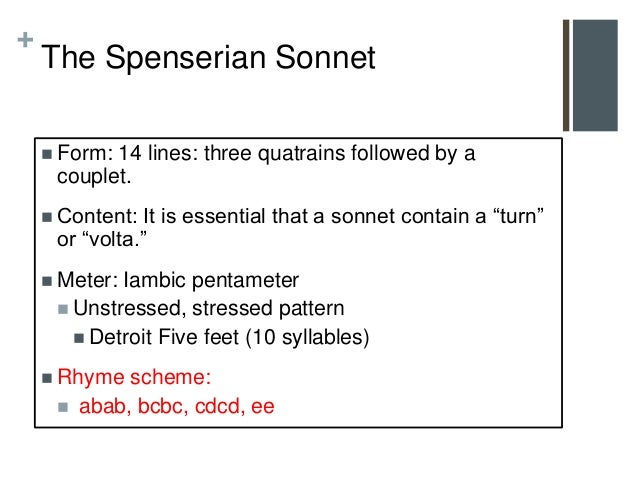

We can see all the telltale signs of Shakespeare’s style of sonnet, such as iambic pentameter, a rhyme scheme of ABAB CDCD EFEF GG, and a final conclusion asking the audience to pay close attention in the final couplet. This is a famous example of sonnet that opens William Shakespeare’s tragedy Romeo and Juliet. ( Romeo and Juliet by William Shakespeare, 1594) What here shall miss, our toil shall strive to mend. The which if you with patient ears attend, Is now the two hours’ traffic of our stage

Which, but their children’s end, nought could remove, The fearful passage of their death-mark’d love,Īnd the continuance of their parents’ rage,

Where civil blood makes civil hands unclean.įrom forth the fatal loins of these two foesĪ pair of star-cross’d lovers take their life ĭo with their death bury their parents’ strife. There is also a noticeable turn toward a conclusion in the the ninth line of “That murmur, soon replies, ‘God doth not need / Either man’s work of His own gifts.” Example #2: Shakespearean Sonnet He uses the conventions established by the first Italian sonneteers with a rhyme scheme of ABBA ABBA CDE CDE. This Petrarchan sonnet example is written in English by the famous poet John Milton. (“When I Consider How My Light is Spent” by John Milton, 1600s) They also serve who only stand and wait.” Is kingly: thousands at His bidding speed,Īnd post o’er land and ocean without rest Who bestīear His mild yoke, they serve Him best. That murmur, soon replies, “God doth not needĮither man’s work or His own gifts. “Doth God exact day-labor, light denied?” My true account, lest He returning chide Lodged with me useless, though my soul more bent Examples of Sonnet in Literature Example #1: Petrarchan SonnetĮre half my days in this dark world and wide,Īnd that one talent which is death to hide William Shakespeare wrote many sonnets, and even used the form in many of his plays, such as the famous prologue to Romeo and Juliet, seen below in Example #2.

Some of the greatest poets in the world have dedicated much time to creating sonnets, such as Dante Aligheri, John Milton, William Wordsworth, Edna St. The Italian poet Giacomo da Lentini created the form in the thirteenth century, and it remains popular to this day with many contemporary poets. Though it has some restrictions on rhyme and meter, it is a relatively open form which allows for a great range of expression in sonnets. The sonnet is one of the most recognizable and common forms to be used in poetry. Modern SonnetĬontemporary poets have continued to expand on the sonnet form, choosing to write in trochees, tetrameter, in blank verse, and with different rhyme schemes, such as AABB CCDD EEFF GG. This provides a tighter connection between the different stanzas. The English poet Edmund Spenser, who lived and wrote during the Elizabethan age, used a slightly different rhyme scheme in his sonnets: ABAB BCBC CDCD EE. While the volta sometimes occurs in the third quatrain, which is to say the ninth line and therefore in the same place as in Italian sonnets, Shakespeare usually saved his change of tone and conclusion just for the couplet. There is also a different breaking of the stanzas-English sonnets are comprised of three quatrains and a couplet. The main different between Italian and English sonnets is the rhyme scheme, which, in Shakespearean sonnets is ABAB CDCD EFEF GG. William Shakespeare was not the first to write sonnets in English, but he became perhaps the most famous sonneteer, and therefore the English form is also sometimes called Shakespearean. The English sonnet is sometimes also known as Elizabethan because they came into popularity in the English language during the reign of Queen Elizabeth I, i.e., in the mid- to late-1500s. English, Elizabethan, or Shakespearean Sonnet There are a few other accepted rhyme schemes for the sestets in Italian sonnets, such as CDD CDE or CDC DCD. The rhyme scheme he used was generally ABBA ABBA for the octave and either CDC CDC or CDE CDE for the sestet. Italian sonnets are known as Petrarchan because the Italian writer Petrarch was one of the main proponents of the form. The ninth line of this sonnet, i.e., the first line of the sestet marks a turn in mood or stance whether or not there is a satisfactory conclusion. The octave proposes a problem or question, and the sestet generally proposes the solution, or leads toward a conclusion. The Italian sonnet, which was created first, is the combination of an octave (eight lines broken into two quatrains) and a sestet (six lines broken into two tercets). All sonnets, whether Italian or English, generally are written in iambic pentameter. Though the definition of sonnet states that the poem must have fourteen lines, there are a few variations with this form.


 0 kommentar(er)
0 kommentar(er)
